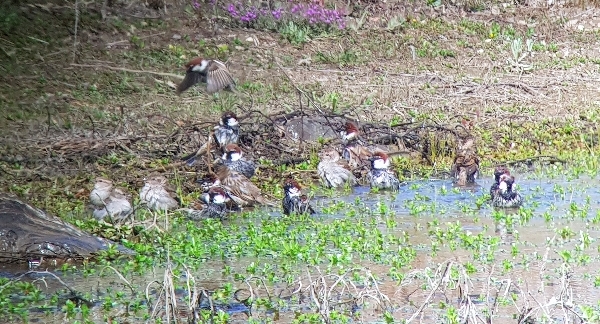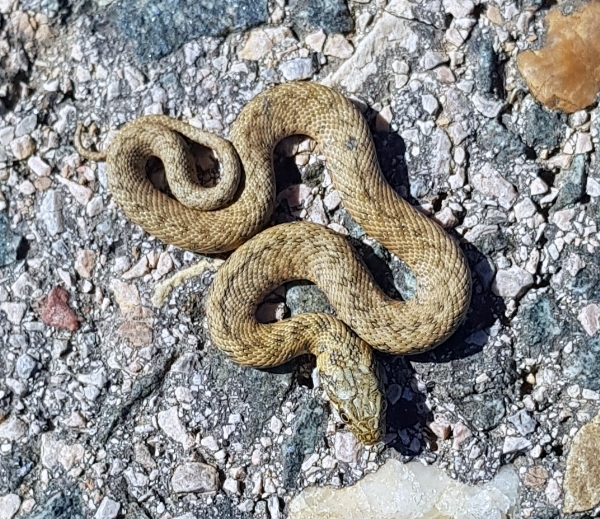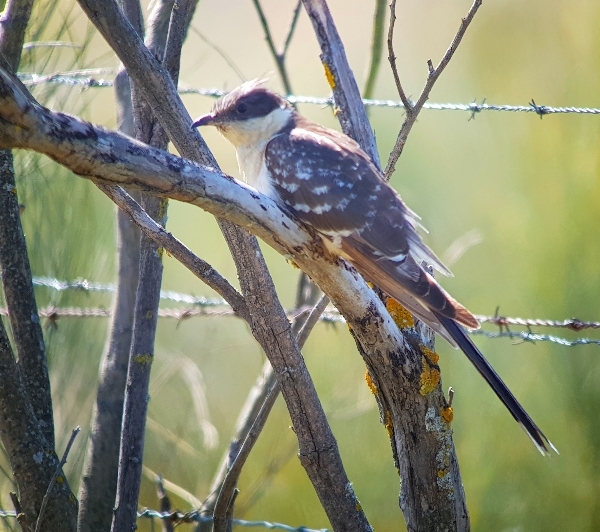
A DAY OUT ON THE PLAINS OF SANTA MARTA AND CÁSERES
WEATHER: wall to wall sunshine all day, a light, cool, breeze increasing in the afternoon. Top temp 18C
Well what a day, all of our target birds in the bag and great views of them too! We collected our picnic breakfasts at 7:15am and set off for Trujillo in the dark. By the time we arrived it was light but really quite chilly, 4C
We stopped on the edge of town to view the Lesser Kestrel colony, it was amazing. A lot of activity with many birds in view, the sky around the colony was full of Kestrels, a kettle of Kestrels. Many sat perched on, or near, the nest boxes at the top of the buildings we had excellent views of them.

a male Lesser Kestrel
Spotless Starlings, Jackdaws, Collared Doves and House Sparrows added to the morning cacophony of bird sound, one Starling was mimicking Nightingale, Bee-eater and Chaffinch and really quite well.
From there we drove out of town in the direction of Cáseres on the old road and after about a couple of k’s we stopped at an old bridge over the Rio Magasca. Bird song rang out from all directions, with Common Nightingale and Cetti’s Warbler competing for the loudest song award! We saw both of those, also Common Kingfisher, Corn Bunting, Crested Lark, Spanish Sparrow, Goldfinch, Zitting Cisticola, Woodchat Shrike and lots of White Storks. A Black-winged Stilt flew over us as we got back into the bus.
Driving slowly towards Cáseres we noted Common Buzzard, Mallard, Griffon Vulture, Iberian (Azure-winged) Magpie, Black Kites and a Marsh Harriers. We turned off towards Santa Marta de Magasca, the landscape changed from Dehesa, to tamarisk & broom scrub to grassland, we stopped on the brow of a hill.

a distant Great Bustard 'strutting his stuff'
From our vantage point we were able to scan a good expanse of the grassland plains and immediately came across a huge flock of Pin-tailed Sandgrouse. Over 100 individuals sat out in the field and the number of larks was incredible. Calandra Larks sang from the ground, on low rocks, fence posts and in the sky, they chased one another pairing off. Crested and Skylarks were also seen and heard and many Corn Buntings had their say too!

the group enjoying sandgrouse sightings
Looking behind us we could see four or five Great Bustards and one male was performing his ‘inside out’ trick! It looked incredible, how could a bird transform into such a ball of colour and fluffiness. He strutted around the females and none of them seemed the least bit interested, in fact after a while most of them flew off.
A short stop back down the lane below the hill was made to look for Stone Curlew, a single individual sat in the tamarisk scrub, we saw more Iberian Magpies, heard a Common Cuckoo and noted our first Iberian Grey Shrike.
Further towards Santa Marta we turn onto a wide track leading down between the grass meadows where we spent a couple of hours enjoying some great birding moments, I enjoy this part of any trip. Perfect weather, great birds to see and an enthusiastic group issuing superlatives as they meet some species for the first time.
We saw more Great Bustards before we found a single male Little Bustard, he was performing his courtship display but only half-heartedly, we couldn’t see a female anywhere. A female Montagu’s Harrier was nice to see, both of these latter species are getting quite hard to find now in this part of Extremadura.
Driving further along the track we found two Black-bellied Sandgrouse before seeing a good flock of them feeding in a pasture full of cows. In fact both species of sandgrouse fed side by side with many more Black-bellied being in view.
As the day warmed up so more and more raptors appeared, vultures mainly but also Marsh Harrier, Short-toed Eagles, Black & Red Kites, Common Kestrel and we found a Little Owl sitting on a wall. We noted Meadow Pipits along the track but did not located a single Short-toed Lark or a Tawny Pipit which was surprising.
After a quick coffee stop in the plaza at Santa Marta we drove on towards Cásares, we stopped for lunch at another bridge, this one spanned the Rio Tamuja, it was so peaceful, no traffic, just the sound of wildlife. Marsh Frogs, the breeze stirring the grass and the leaves of the trees and broom shrubs. We watched Crag Martins building their nests and White Wagtails chasing along the stream, we also noted Common Stonechat, Chaffinches and Blackcaps practicing their summer song.
‘Roller’ alley was our next venue. This is an area on the Llanos of Cáseres, an area of undulating hills, with rocky outcrops, some broom scrub and open pasture. A line of disused telegraph poles have been furnished with modern (none wooden) nest boxes, specifically for the European Roller. There are hundreds of boxes out there, most are taken by Jackdaws, Lesser Kestrels, Common Kestrels and Starlings, but Rollers do use them. We saw one individual European Roller, it was beautiful and well appreciated by the group.
We then turned onto a side track and began a bumpy journey which was to last nearly two hours, boy was the track in need some TLC. Despite our slow progress and the bumpy ride we enjoyed some great birding. Watching Hoopoes. European Bee-eaters, Woodchat & Iberian Grey Shrikes, Red-legged Partridges, our first Northern Wheatears and no-end of raptors. We had excellent views of our first Booted Eagles and enjoyed more Short-toed Eagles and of course the Vultures and kites. An Egyptian Mongoose ran across the track in front of the bus.

Spanish Sparrows taking a bath
Finally we arrived at the Embalse de Talavan where we spent the late afternoon making some fantastic sightings especially of cuckoos. After visiting the roadside hide area where saw Spanish Sparrows ( a colony with literally thousands of pairs), also Zitting Cisticola, we found a very young Viperine Snake on the road (so we rescued it) and our first Spanish Festoon butterfly.

Viperine Snake seen on the road at Embalse Talavan
Driving round to the dam area we bumped into a Great Spotted Cuckoo, an excellent find by Vanessa from the back of the bus. We went on to see at least three more of these enigmatic parasites, they flew around making all kinds of noises and giving us excellent views.

Great Spotted Cuckoo
The water of the reservoir was poorly furnished with birds, just one pair of Mallards, a single Great Crested Grebe, three Northern Lapwings and a couple of Green Sandpipers, we did see a very distant plover (probably Little-ringed) but it disappeared. We saw a Common Cuckoo in flight as we bumped along the dirt track back to the road.

the Rio Almonte near Cáseres
Our very last stop of the day was the large bridge over the Rio Almonte as we headed back towards Torrejón el Rubio. The river level was so low you could see two older bridges which had be submerged but now exposed by the lack of water. Our short visit was superb, the late afternoon sunlight was exquisite, the wild flowers and butterflies were a joy to see, we noted Brimstone Butterflies, Small Copper, Small Heath, Western Dappled White, a Silver ‘Y’ Moth and a new Orchid for the list, Sawfly Orchid.

Sawfly Orchid
We watched a pair of Hoopoes entering holes in stone wall looking for food or a prospecting for a nest site? We saw Black Wheatear, hundreds of House Martins, Crag Martins and one or two Alpine Swifts. We called it day after that visit and headed back to the hotel. It took twenty minutes to return to the hotel, arriving around 6:30pm.
Dinner was a joyous affair, the menu was good, the wine was flowing and spirit of the group was amazing, I have never heard so much laughter, things are going well, me thinks!
